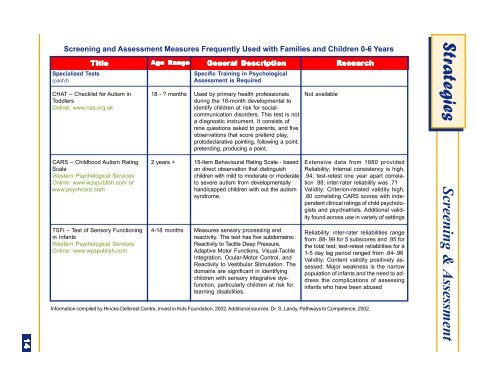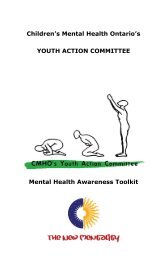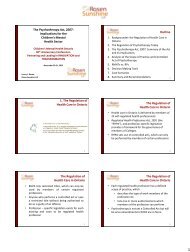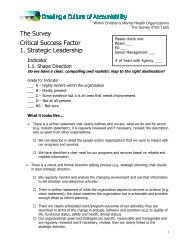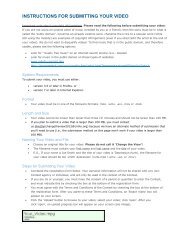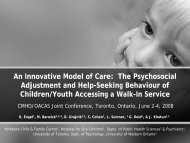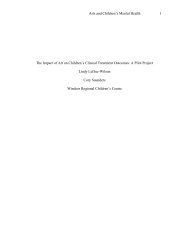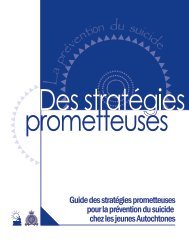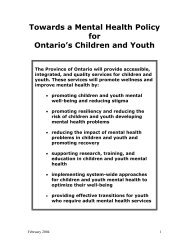Early Childhood Mental Health Treatment: Training Reference Guide
Early Childhood Mental Health Treatment: Training Reference Guide
Early Childhood Mental Health Treatment: Training Reference Guide
You also want an ePaper? Increase the reach of your titles
YUMPU automatically turns print PDFs into web optimized ePapers that Google loves.
14<br />
Screening and Assessment Measures Frequently Used with Families and Children 0-6 Years<br />
Title<br />
Specialized Tests<br />
(cont’d)<br />
CHAT – Checklist for Autism in<br />
Toddlers<br />
Online: www.nas.org.uk<br />
CARS – <strong>Childhood</strong> Autism Rating<br />
Scale<br />
Western Psychological Services<br />
Online: www.wpspublish.com or<br />
www.psychcorp.com<br />
TSFI – Test of Sensory Functioning<br />
in Infants<br />
Western Psychological Services<br />
Online: www.wpspublish.com<br />
Age Range<br />
18 - months<br />
2 years +<br />
4-18 months<br />
General Description<br />
Specific <strong>Training</strong> in Psychological<br />
Assessment is Required<br />
Used by primary health professionals<br />
during the 18-month developmental to<br />
identify children at risk for socialcommunication<br />
disorders. This test is not<br />
a diagnostic instrument. It consists of<br />
nine questions asked to parents, and five<br />
observations that score pretend play,<br />
protodeclarative pointing, following a point,<br />
pretending, producing a point.<br />
15-Item Behavioural Rating Scale - based<br />
on direct observation that distinguish<br />
children with mild to moderate or moderate<br />
to severe autism from developmentally<br />
handicapped children with out the autism<br />
syndrome.<br />
Measures sensory processing and<br />
reactivity. The test has five subdomains:<br />
Reactivity to Tactile Deep Pressure,<br />
Adaptive Motor Functions, Visual-Tactile<br />
Integration, Ocular-Motor Control, and<br />
Reactivity to Vestibular Stimulation. The<br />
domains are significant in identifying<br />
children with sensory integrative dysfunction,<br />
particularly children at risk for<br />
learning disabilities.<br />
Not available<br />
Resear<br />
esearch<br />
Extensive data from 1980 provided<br />
Reliability: Internal consistency is high,<br />
.94; test-retest one year apart correlation<br />
.88; inter-rater reliability was .71<br />
Validity: Criterion-related validity high,<br />
.80 correlating CARS scores with independent<br />
clinical ratings of child psychologists<br />
and psychiatrists. Additional validity<br />
found across use in variety of settings<br />
Reliability: inter-rater reliabilities range<br />
from .88-.99 for 5 subscores and .95 for<br />
the total test; test-retest reliabilities for a<br />
1-5 day lag period ranged from .64-.96<br />
Validity: Content validity positively assessed.<br />
Major weakness is the narrow<br />
population of infants and the need to address<br />
the complications of assessing<br />
infants who have been abused<br />
Information compiled by Hincks-Dellcrest Centre, Invest in Kids Foundation, 2002. Additional sources: Dr. S. Landy, Pathways to Competence, 2002.<br />
Strategies Screening & Assessment


